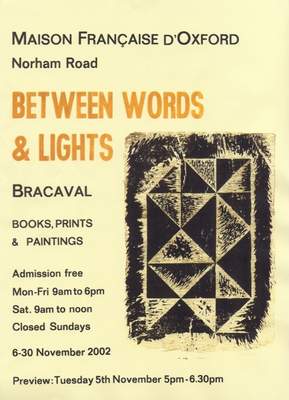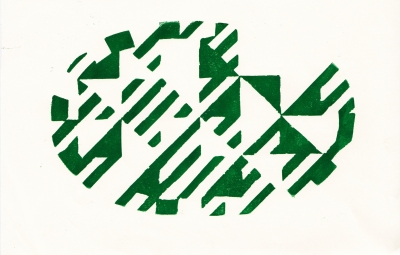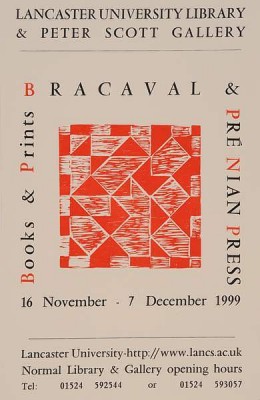PRINTING WORKSHOPS
with Pré Nian Press
Pré Nian
Bertrand Bracaval, Le rêve et la méthode, Pré Nian: trente
années d'édition Pré Nian, 2008
Reviewed by Lindsay Newman
The work of the Pré Nian press is largely a geopoetic celebration of the river Loire, which played a more important role in the history of Nantes than in that of any other town in the Loire valley. The very name of the press has a strong historical resonance : Le Pré Nian still exists today as a small street in the medieval quarter of Nantes, which took its name from the decisive battle in 937 when Alain Barbetorte defeated the Normans who had occupied the town for over a century. This marked a turning point in the history of Brittany.
Nantes owed its prosperity to the fact that it was an estuary town: from the fourteenth century, it rose to become a commercial port with transatlantic links, and in the nineteenth, shipbuilding became a driving force of the regional economy. Between the two world wars the arms of the Loire and the Erdre were filled in; thus traffic could circulate and the town turned away from its river. Then in the 196os the shipyards were transferred to St Nazaire.
Nevertheless the river continues to exercise its magnetic power over inhabitants and visitors alike. This is evident in both the content and style of the small books printed and published by Bertrand Bracaval at his Pré Nian press, for the sea, water, mists, sun, bird song, skies, clouds, rain, wind, light, dark, twilight, dreams, night, silence and absence permeate their pages.
In 1978 Bracaval issued the first of what was to become a series of Cahiers running to number 7 in 1986 and printed on a hand press in editions ranging from 3o to 85 copies. In them a text, normally a poem, is presented in parallel with an abstract image reproduced by silkscreen. In 1982 the Cahiers were joined by, and eventually gave way to, independent volumes, created by an association — or collective — of poets and artists, all well known within the region. The emphasis on silkscreen continued, but was gradually replaced by woodcuts, linocuts and etchings, and more elaborate bindings.
The most widely-celebrated author in the field of geopoetics to join Pré Nian was the Scotsman Kenneth White, who published in French before writing in English and who contributes a foreword to this catalogue. White had grown up in Fairlie, a village on the west coast of Scotland, just south of Largs, and so felt at ease in Nantes. In addition, two of his poems are used as the title of the book under review.
Another Scot was Alistair Paterson, author of Touchings and Overcast, while members of the collective extended further into Belgium, Hungary, the USA and Canada. They included Savitskaya, Csoori, Ferlinghetti and Gilles Cyr.
A most important feature of the work of the Pré Nian press were the exhibitions, readings and book signings held throughout France and abroad: in the UK, Belgium, Germany, Poland, Hungary and the USA. To mark the occasion for which this catalogue—antholog-y was produced, the books concerned were displayed in Paris, in the Galeri La Hune Brenner in Montmartre and in the library of the Musée des Arts Décoratifs during September and Octobe 2008. There was- also a window display in the original ''English bookshop'', the Librairie Galignani in the rue de Rivoli.
The modesty of this small catalogue of artists' book belles their longevity and range. It serves as an excellent reminder of the exhibitions or as a short history of the press for those who have not seen them. What we miss despite the cover, which evokes a fine drizzle, and the, generous number of reduced colour reproductions, are the tactile elements — the voluptuous feel of hand-made paper and the kiss of the type on it.
Printing workshops are run in the summer months at the Pré Nian, which clearly has a vocation for survival fostered by its begetter Bracaval, painter, printer, and indefatigable publicist.
A more detailed article on Bracaval's work by Lindsay Newman appeared in 'Parenthesis' 4.
Book reviews
Parenthesis 18 Spring 2010
*****
In the early 1970s, Bracaval became renowned in the contemporary art world for his mastery of large formats, color, and generous gesture.
Bracaval has always remained faithful to abstract painting with no apparent subject matter, and has continuously enriched and enhanced his style. Living in the countryside has prevented him from losing touch with nature, landscapes, the light of large open spaces, the colors of the earth and the sky. Far from the hustle and bustle of the city, the silence he chooses may limit his familiarity with day-to-day affairs, but his art has improved its profundity. His evolution surprises only those who confuse renewal with novelty.
He uses simple forms (triangles, squares, rectangles) to structure the space, spread out the surfaces, and delimit the zones of his work. The geometry of the art, meanwhile, is but the beginning. In the general synergic organization of a painting, each part has its own matter and light, yet does not function independently of the others.
Engraving (in wood or metal) is merely a progression in the continuum of the work of a painter, in which the objective is to engage all the “states” in the arrangement of the work of art. It is easy to understand why for more than twenty years Bracaval has made books, asking literary friends for poetry to accompany his own engravings. From the choice of paper to the typography to the printing by hand, every moment in the execution of a work of art reflects the savoir faire of the artist, who undeniably disdains any flamboyant demonstration of his own virtuosity.
For this reason, the books published by les Editions le Pré Nian are not “precious” but simply rare.
Vincent Rousseau
- SILKSCREEN
- ETCHING
- WOODCUT
- TYPOGRAPHY
- LINOCUT
- HAND-MADE PAPER
Since 30 years Pré Nian has been publishing Artists'books, now in national libraries and private collection in several countries.
- Workshops :
Two courses of five days open to five persons interested in etching, typography and silkscreen practices : end of July - begining of August. Accomodations possible.
Write or call Bertrand Bracaval :
Editions
Le Pré Nian
Retaud, 44530 GUENROUET - FRANCE
Tel. : 00 (33) 2 40 87 70 40
mail : pre-nian@wanadoo.fr
or
for groups starting from UK:
Inquire
Alistair Paterson
email:
prism.atic@virgin.net

NO PROFIT ASSOCIATIONS, A NEW WAY TO PROMOTE ART?
In a thesis for the Diplôme des Hautes Etudes de Pratiques Sociales, Maine University, Le Mans, France, the painter and publisher Bertrand Bracaval tries to explain how the art market has changed during this century, since the time when art dealers were able to promote unknown artists until the last twenty years during which more and more artists have been creating their own forms of circulation.
Comparing the case of Picasso, Chagall, etc. who came to Paris and found dealers to help them, and later the influence of museums and institutions spreading official art, the author recalls the example of Russian avant-garde painters who were the pioneers in making and circulating artists’ books. He shows how art galleries and museums cannot embrace the totality of living art. The wave of self-publishing, even on a very small scale, has produced a large number of private presses in all fields and created new conceptions of printing, either with ancient hand presses or by computer, reflecting various sensibilities which would otherwise have been long forgotten. Starting from the fact that, in the media era, you have to be already known to be trusted, he endeavors to analyze this movement which has given rise to book fairs in numerous countries, and has obviously become a matter of debate.
The links between
the artists, writers, different editions and studios contribute to another
relationship in the art world, and even if many creators still preserve
necessary solitude, many also join forms of associations to manage their
activities. This aspect introduces the question of the possibility for
artists to change mentalities in art, and thus their own destiny. He concludes
that the situation with information technology, fax, internet and so on
is moving into a state that prevailed in the past, when no market existed
and direct contacts were
possible.

